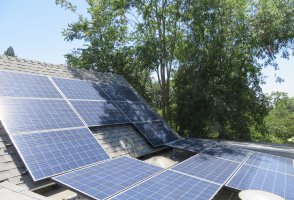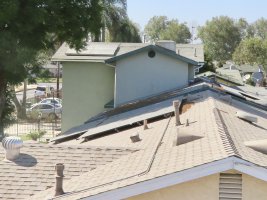-
Welcome to The Building Code Forum
Your premier resource for building code knowledge.
This forum remains free to the public thanks to the generous support of our Sawhorse Members and Corporate Sponsors. Their contributions help keep this community thriving and accessible.
Want enhanced access to expert discussions and exclusive features? Learn more about the benefits here.
Ready to upgrade? Log in and upgrade now.
You are using an out of date browser. It may not display this or other websites correctly.
You should upgrade or use an alternative browser.
You should upgrade or use an alternative browser.
Throwing shade on solar.
- Thread starter ICE
- Start date
Yankee Chronicler
SAWHORSE
As long as the check clears …
Too true.
Energystar
SAWHORSE
Some areas have solar easements to keep your neighbor from blocking your panels.
jar546
CBO
That makes sense.Some areas have solar easements to keep your neighbor from blocking your panels.
Three of the examples are shaded by their own trees. The fourth is shaded by a mature tree on a neighboring property. I doubt that any jurisdiction will cause people to remove existing trees. Another quandary has to do with buildings. Will the neighbor be prohibited from building a structure that would shade a solar array?Some areas have solar easements to keep your neighbor from blocking your panels.
jar546
CBO
That's what an easement is.Will the neighbor be prohibited from building a structure that would shade a solar array?
Inspector Gadget
REGISTERED
Meh, nuttin' that a Husqvarna wouldn't solve.
jar546
CBO
I prefer the Husqvarna 701 Super MotoMeh, nuttin' that a Husqvarna wouldn't solve.
I don’t think that would apply to existing trees or structures on neighboring properties. In the pictures Ice posted the shading is caused by an incompetent or shady contractor. Or … the HO demanded panels, the installer recommended against it, HO insisted. Got to get that free government tax break.Some areas have solar easements to keep your neighbor from blocking your panels.
A solar easement is voluntary. There is no way to restrict a neighbor from shading your array unless there is a voluntary solar easement.That's what an easement is.
tbz
SAWHORSE
Back in the early and mid 80's I did my fair share of large dish installs in rule areas. More than a few for clients, that had more tree coverage than ever could work.
When told them their property was not going to be ideal because of all the tree coverage, they informed me to install it on the roof there and let me deal with the trees later.
Sometimes, not always things are different when you take a deeper look and not call it until all the facts are on the table.
When told them their property was not going to be ideal because of all the tree coverage, they informed me to install it on the roof there and let me deal with the trees later.
Sometimes, not always things are different when you take a deeper look and not call it until all the facts are on the table.
Inspector Gadget
REGISTERED
Just purchased a Stihl 291 with a 20" bar, and I'm delighted with it.I prefer the Husqvarna 701 Super Moto
I have to use it clear some space for an addition to my solar system. (Look, how's that for a topic return segue?)
fatboy
Administrator
jar546
CBO
LOL when you think Husqvarna, you think chainsaws and I think motorcycles.Just purchased a Stihl 291 with a 20" bar, and I'm delighted with it.
I have to use it clear some space for an addition to my solar system. (Look, how's that for a topic return segue?)
mark handler
SAWHORSE
Getting back on topic
Many times, the owners are informed about trimming the trees, and they don't.
you might want to look at this, California’s Solar Shade Control Act
Many times, the owners are informed about trimming the trees, and they don't.
you might want to look at this, California’s Solar Shade Control Act
The paper explains the law with regards to shading solar collectors. On page nine there is a series of questions that when answered will indicate if there is a violation of the Act. The following screen shot is from the list that an owner of a tree can use to determine if a violation of the Act exists.

That is the single mention of this in the document and I found no mention of this concept in the Act. It is possible that I missed an explanation of "offset more than the building's electricity demand" however, that's a barn door open for interpretation. Nearly every residential system is intended to send power to the grid when the onsite demand falls below what the system produces.
I lack insight for a followup to that.
One thing made clear is that the Act does not apply to trees or shrubs that predated the installation of a solar collector. There are hurdles to be dealt with such as a timely written notice to the neighbors but implementation of the Act is straightforward.
mark handler
SAWHORSE
When properly designing a solar system, the building's electricity demand is used to determine the number of panels needed to meet the electrical demand for the building.
The Energy code, in CA, requires new structures to meet the energy requirements for that structure. The energy grid like a garden hose cannot handle an excess of energy flowing into it. The size of the hose, or the transmission and distribution system has a maximum “capacity.”
They do not necessarily want you to exceed that. The intent is to not produce more energy than required because they do not want to unbalance the energy grid.
The Energy code, in CA, requires new structures to meet the energy requirements for that structure. The energy grid like a garden hose cannot handle an excess of energy flowing into it. The size of the hose, or the transmission and distribution system has a maximum “capacity.”
They do not necessarily want you to exceed that. The intent is to not produce more energy than required because they do not want to unbalance the energy grid.
Yikes
SAWHORSE
When properly designing a solar system, the building's electricity demand is used to determine the number of panels needed to meet the electrical demand for the building.
The Energy code, in CA, requires new structures to meet the energy requirements for that structure. The energy grid like a garden hose cannot handle an excess of energy flowing into it. The size of the hose, or the transmission and distribution system has a maximum “capacity.”
They do not necessarily want you to exceed that. The intent is to not produce more energy than required because they do not want to unbalance the energy grid.
Hawaiian homeowners were early adopters of solar PV due to the high cost of power generation over there. I remember reading about how difficult it was for the utility companies to respond to demand such a small/isolated grid on a windy day when a cloud would suddenly drop home energy production in an entire town, and then just as suddenly the sun would emerge again. The spikes and dips were large and immediate.





